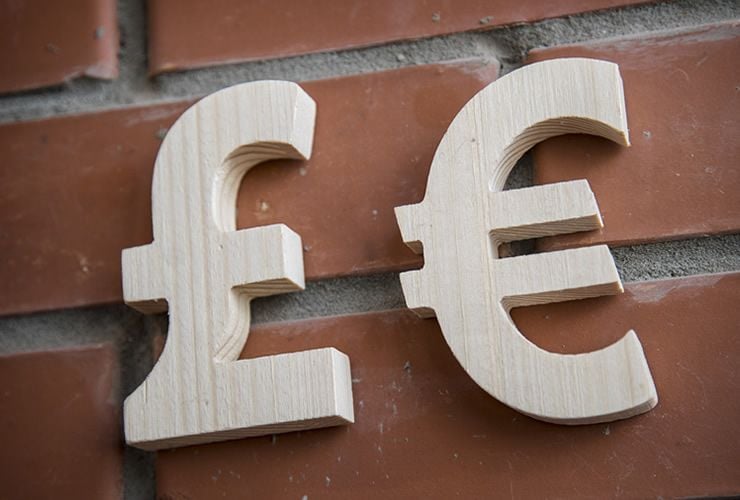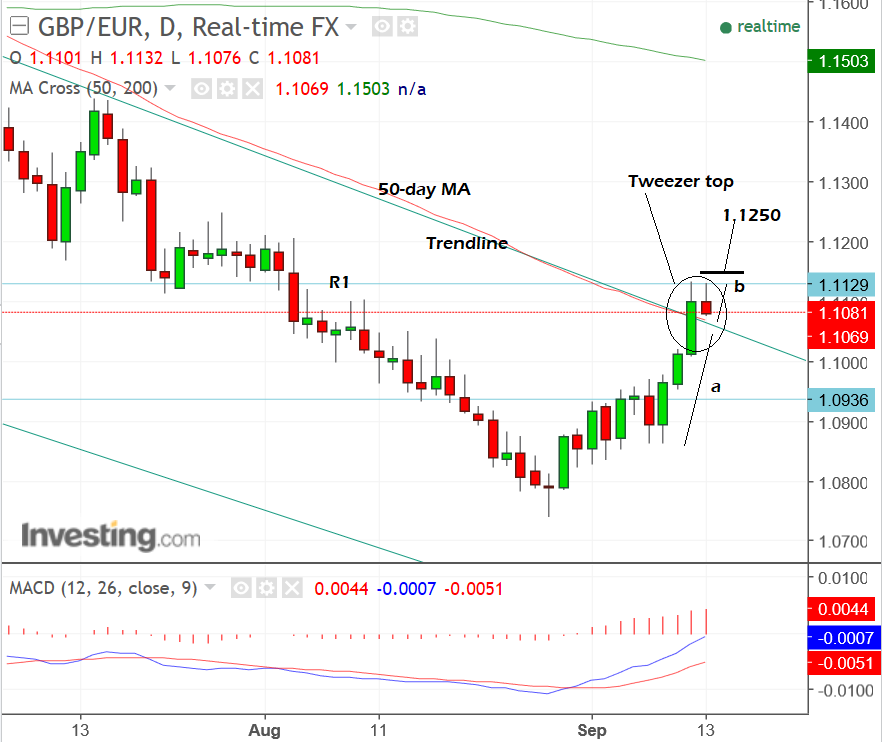Pound-to-Euro Rate's Uptrend Intact Short-Term, Longer-Term Still Liable to Decline

The Pound-to-Euro exchange rate has pulled back from a multi-week best at 1.1130 as a pause in the uptrend is signalled by a technical formation known as a 'tweezer top'. Longer-term, direction remains pointed lower.
Our latest technical studies confirm the GBP/EUR conversion's short-term trend higher remains intact and the strong move up from the late August lows, as well as the break of the trendline and moving average favour more upside.
The gains come as a relief for those looking to buy Euros with Sterling, particularly those who held on for higher rates having witnessed the eight-year low sub-1.08 yielding to a multi-week best at 1.1130 on Tuesday, September 12.
The pair has meanwhile surpassed the upside target from our 'week ahead' report published on Sunday and we see no reason to doubt the trend moving even higher.
According to technical theory, the Pound-to-Euro conversion will probably rise the same distance above the trendline - the length of which is labeled ‘b’ - as it did in the move below the trendline prior to the break, labeled ‘a’.

This suggests an extension of about 200 points, which taken from the breach at 1.1075 recommends a target at about 1.1275.
We have decided to be a little more cautious and set a target at 1.1250.
One negative sign is the potential tweezer top pattern which has formed over the last two days as a result of the exchange rate reaching a very similar high of around 1.1130 on both consecutive days, following a similar open level.
Tweezer tops are bearish reversal patterns and if today’s price action fails to rally above the day’s highs already set, the pattern will remain in place and indicate more downside for the pair in the short-term, however, tomorrow’s volatility could overrule technical signals.
It will be difficult for the exchange rate to break back below the trendline, as well, making a reversal even less likely.
It is more likely the pair will find support at the trendline and then resume its uptrend eventually, and the pull-back today, could even be characterised as just a temporary throwback move.
A major obstacle sits in the way of further upside at 1.1130, however, in the form of the R1 monthly pivot, which is a level used by traders to trade counter to the trend.
We would first want to see a clear break above the pivot before forecasting a continuation higher, and such confirmation would come from a move above the 1.1155 level.
Such a move would activate the aforementioned upside target at 1.1250.
Get up to 5% more foreign exchange by using a specialist provider by getting closer to the real market rate and avoid the gaping spreads charged by your bank for international payments. Learn more here.
While the shorter-term picture is constructive for those hoping for a stronger Pound, longer-term the bias for a softer currency remains.
"Long EUR/GBP has been one of our top macro trades for 2017 and we remain bearish GBP," says John Wraith, a strategist with UBS in London.
There are multiple drivers for Sterling and Wraith says the UK's current account imbalances (the country imports more than it exports) remain the main medium-term driver for Sterling as opposed to the Bank of England.
"Increasingly complex Brexit negotiations also pose downside risks for GBP and we see EUR/GBP at 0.97 by end-2018," says Wraith.
EUR/GBP at 0.97 gives a GBP/EUR rate at 1.03.
Employment Data Caps the Pound's Advance but Majority of Gains Held
Looking at the near-term fundamental picture, capping Sterling's gains mid-week is the release of labour market data from the Office for National Statistics.
The data confirmed the UK economy continues to offer more jobs with the unemployment rate dipping down to 4.3%.
But Pound Sterling eased off recent highs on news that UK wage growth read at 2.1% in July, unchanged on the previous month's figure.
Markets had forecast 2.3% growth, and it is because of this miss on expectations that the Pound has edged lower.
With wage growth at 2.3%, and inflation at 2.9%, it is clear the average citizen is getting poorer.
"Sterling traders didn’t know what card to play. Sterling lost a few ticks after the release, but maintained most of its recent gains," says Piet Lammens at KBC Markets in Brussels.
Rising inflation and stalled wage growth will have a knock-on effect on spending elsewhere in the economy and might help explain why the UK's economic growth rate has come off the boil in 2017.
"While the continued strength of employment will be welcomed by the MPC, the continued absence of a pick-up in wage growth is likely to keep the doves in the majority. And with inflation reaching 2.9% in August, the squeeze on households’ real incomes probably intensified. That would make the risk of a sharper downturn in consumer spending the overwhelming concern to the majority of the MPC members," says Andrew Wishart, UK Economist at Capital Economics.
The Bank of England will therefore surely mention unease with the ongoing inflationary pressures which are now exceeding the forecasts laid out by the Bank in their August Inflation Report.
Any such mention would be beneficial for the Pound and could cement the recent recovery.




